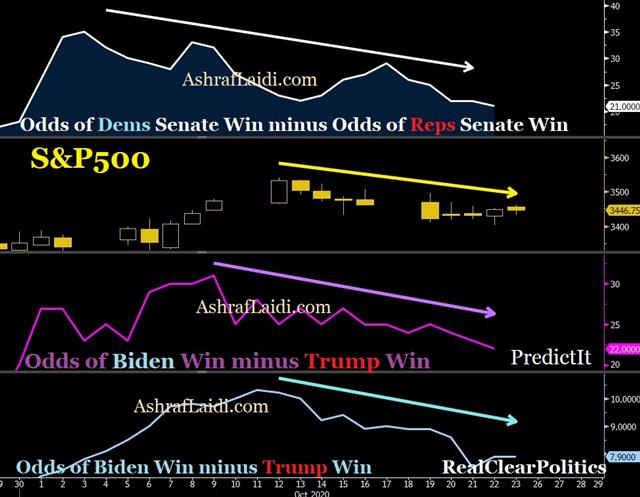After the Blue Wave

1) Lame duck stimulus
The market continues to get bounced around by stimulus headlines but this is clearly a game where neither side wants to appear to be walking away. Pelosi highlighted progress on Thursday but was asked at the end of her press conference if there had been progress on state & local funding or liability, she said 'no'. Those are the two areas that have held up negotiations for months and doom hopes for a real deal.So the question after the election is whether a deal is possible in the lame duck session in November, before the new congress is sworn in. Assuming a blue wave, it appears highly unlikely unless it's something small and targeted towards hard hit businesses like airlines. For the broader economy, it's going to have to wait. That's likely to trigger severe market disruptions even with a huge package on the way in January/February. Can the market look through it? Probably but it will be a tough test.
2) COVID resurgence
France and Holland reported record case numbers on Thursday and the US is clearly seeing an uptick in cases again. US cases regained the 70K mark, while Italy, France and Luxembourg will announce curfews. Another wave is here and the speed of the rise in cases – particularly in France and a few US states – is troublesome. Flu season doesn't peak until February and expectations for growth around 4% annualized in Q4 and Q1 are too optimistic. Again the question will be whether the market can look through it and based on the past six months the answer is that it probably can, but the wall of worry is building.3) Negative rates
Central banks in a number of countries are flirting with negative rates and given the expected virus resurgence and concurrent slowdown, the odds that they're used is rising. The hollowing out of eurozone banks might be a coincidence but the financial sector is one of the big laggards coming out of the pandemic and negative rates are one of the main reasons why. If there's some success in Australia or the UK, could the Fed have another look?Other themes to watch will be: digital currency adoption, rising home prices, inflationary pressures, a green energy boom, OPEC's December meeting, Biden's promise to hike taxes 'on day 1'.
Join Ashraf for his webinar on the latest lntermarket fractals applications next Tuesday (Oct 27) at 17:10 Eastern (21:10 London/GMT) (time difference will be 4 hrs not 5 hrs during that week).

Latest IMTs
-
Falling to 11 Percent
by Ashraf Laidi | Jan 7, 2026 20:28
-
Dollar Cannot Wait for Q1 to End
by Ashraf Laidi | Jan 6, 2026 12:40
-
Silver's Signal to Gold Full Explanation
by Ashraf Laidi | Dec 30, 2025 20:04
-
Gold Silver Next الذهب و الفضة
by Ashraf Laidi | Dec 26, 2025 17:15
-
Everyone's Talking about this Risk
by Ashraf Laidi | Dec 24, 2025 14:08








